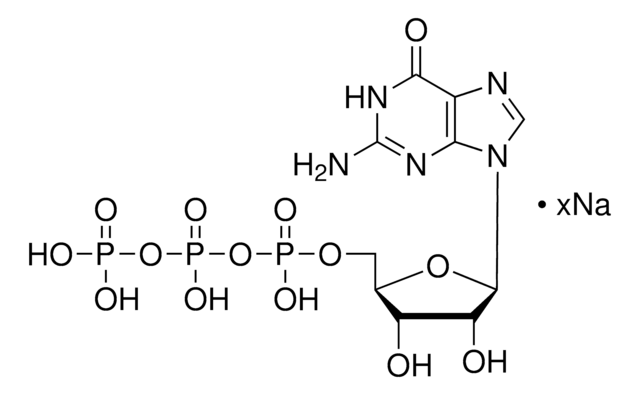I1643
Pyrophosphatase, Inorganic from baker′s yeast (S. cerevisiae)
powder, ≥500 units/mg protein (E1%/280)
Synonyme(s) :
Inorganic Pyrophosphatase, Pyrophosphate phosphohydrolase
About This Item
Produits recommandés
Forme
powder
Niveau de qualité
Activité spécifique
≥500 units/mg protein (E1%/280)
Poids mol.
71 kDa
Température de stockage
−20°C
Vous recherchez des produits similaires ? Visite Guide de comparaison des produits
Description générale
Extinction Coefficient: E1% = 14.5 (280 nm)
pI: 4.75
This ubiquitous enzyme serves to drive metabolic reactions that produce pyrophosphate, since these reactions typically have equilibrium constants near unity. The catalytic mechanism has been described in the literature. Inorganic pyrophosphatase is a metalloprotease that requires Mg2+ for maximal activity. Although the hydrolysis of inorganic pyrophosphate is specific in the presence of Mg2+, both ADP and ATP can be hydrolyzed if zinc is present.
Application
It plays an important role in protein, RNA, and DNA synthesis.
- as a component of the reaction buffer used in aminoacylation assay to quantify incorporation of [3H]L-methionine into tRNA.
- as a component of PCR mixture.
as a component of the reaction buffer used in aminoacylation assay to quantify incorporation of [3H]L-methionine into tRNA.
as a component of PCR mixture
Définition de l'unité
Forme physique
Code de la classe de stockage
11 - Combustible Solids
Classe de danger pour l'eau (WGK)
WGK 3
Point d'éclair (°F)
Not applicable
Point d'éclair (°C)
Not applicable
Équipement de protection individuelle
Eyeshields, Gloves, type N95 (US)
Certificats d'analyse (COA)
Recherchez un Certificats d'analyse (COA) en saisissant le numéro de lot du produit. Les numéros de lot figurent sur l'étiquette du produit après les mots "Lot" ou "Batch".
Déjà en possession de ce produit ?
Retrouvez la documentation relative aux produits que vous avez récemment achetés dans la Bibliothèque de documents.
Notre équipe de scientifiques dispose d'une expérience dans tous les secteurs de la recherche, notamment en sciences de la vie, science des matériaux, synthèse chimique, chromatographie, analyse et dans de nombreux autres domaines..
Contacter notre Service technique






